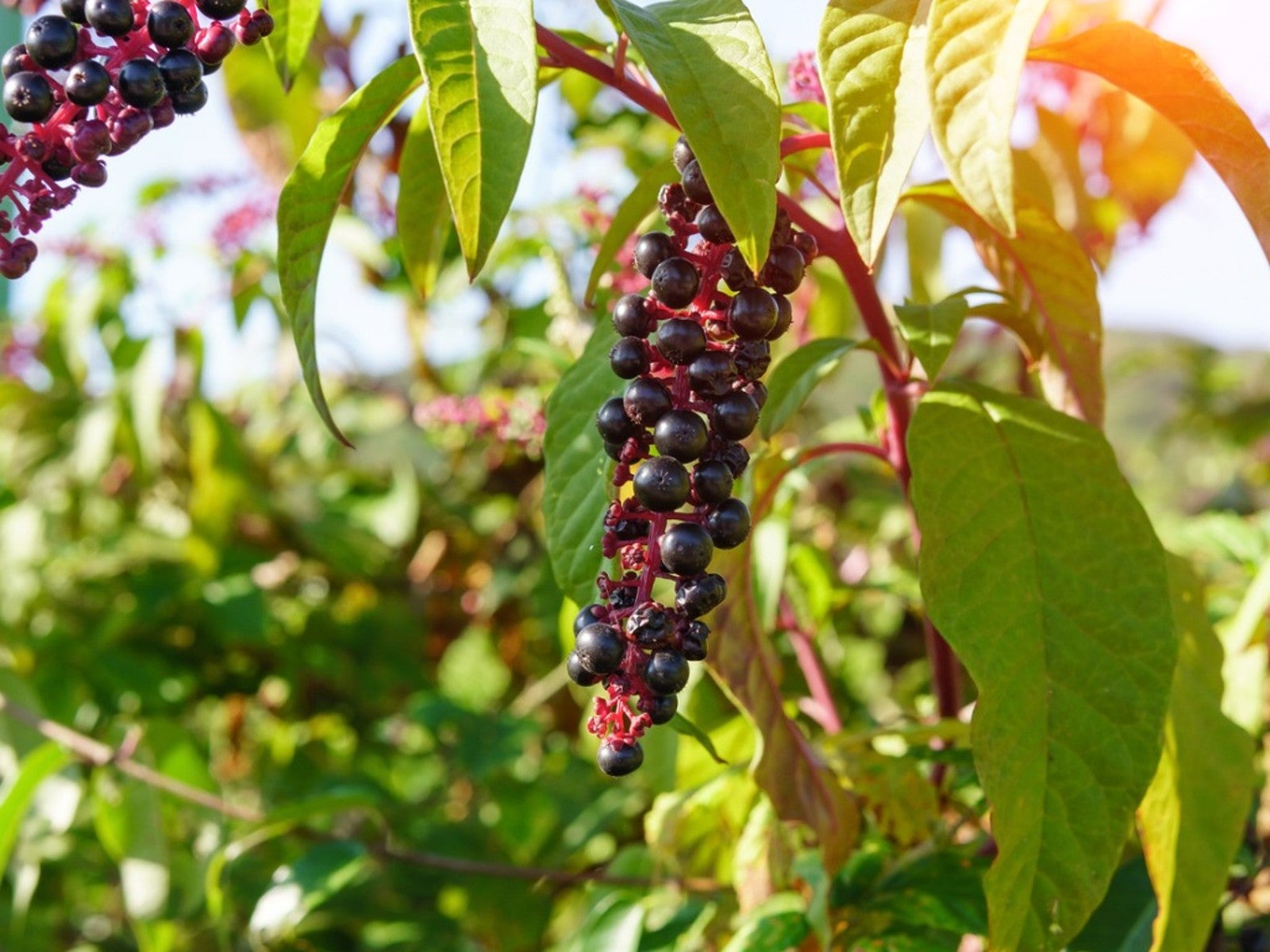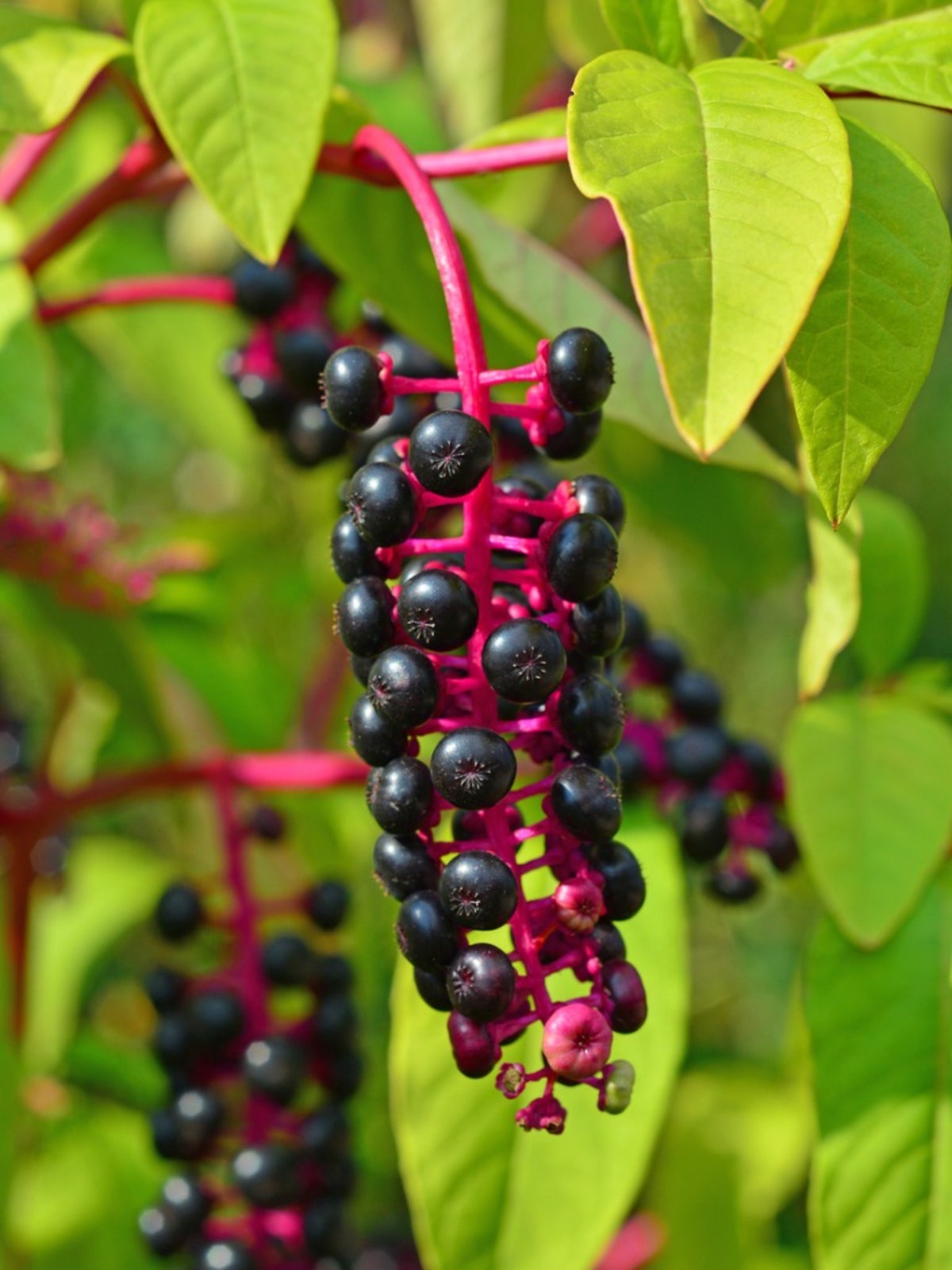Pokeweed In Gardens – Tips On Growing Pokeberry Plants In The Garden

Pokeberry (Phytolacca americana) is a hardy, native perennial herb that can be found commonly growing in the southern regions of the United States. To some, it’s an invasive weed meant to be destroyed, but others recognize it for its amazing uses, pretty magenta stems, and/or its purple berries that are a hot commodity for many birds and animals. Interested in growing pokeberry plants? Read on to find out how to grow pokeberries and what uses there are for pokeberries.
Information on Pokeweed in Gardens
First of all, most people don’t actually cultivate pokeweed in their gardens. Sure, it very well might be there, growing wild along the fence or in the garden, but the gardener didn’t actually plant it. The birds had a hand in the sowing of the pokeberry. Each pokeberry devoured by a hungry bird has 10 seeds with an outer coating that is so hard the seeds can remain viable for 40 years!
The pokeweed, or pokeberry, also goes by the name of poke or pigeonberry. Pretty much labeled as a weed, the plant can grow 8 to 12 feet (2-4 m.) in height and 3 to 6 feet (1-2 m.) across. It can be found in Sunset zones 4 through 25.
Along the magenta stems hang spearhead-shaped 6 to 12 inch (15-31 cm.) long leaves and long racemes of white blooms during the summer months. When the flowers are spent, green berries appear that slowly ripen to almost black.
Uses for Pokeberries
Native Americans used this perennial herb as a salve and a cure for rheumatism, but there are many other uses for pokeberries. Many animals and birds gorge themselves on the berries, which are toxic to people. In fact, the berries, roots, leaves, and stems are all toxic to humans. This doesn’t prevent some people from ingesting the tender spring leaves, though. They pick the young leaves and then boil them at least two times to remove any toxins. The greens are then made into a traditional spring dish called “poke sallet.”
Pokeberries were also used for dying things. Native Americans dyed their war ponies with it and during the Civil War, the juice was used as ink.
Pokeberries were used to cure all manner of ills from boils to acne. Today, new research points to pokeberry use in cancer treatment. It is also being tested to see if it can protect cells from HIV and AIDS.
Gardening tips, videos, info and more delivered right to your inbox!
Sign up for the Gardening Know How newsletter today and receive a free copy of our e-book "How to Grow Delicious Tomatoes".
Lastly, researchers at Wake Forest University have discovered a new use for the dye derived from pokeberries. The dye doubles the efficiency of fibers used in solar cells. In other words, it boosts the productivity of solar energy.
How to Grow Pokeberries
While most Americans don’t actually cultivate pokeweed, it seems that Europeans do. European gardeners appreciate the shiny berries, colorful stems, and lovely foliage. If you do too, growing pokeberry plants is easy. Pokeweed roots can be transplanted in the late winter or seeds can be sown in the early spring.
In order to propagate from seed, collect the berries and crush them in water. Let the seed sit in the water for a few days. Skim off any seeds that float to the top; they aren’t viable. Drain the remaining seeds and allow them to dry on some paper towels. Wrap the dry seeds in a paper towel and place them in a Ziploc-type baggie. Store them at around 40 degrees F. (4 C.) for three months. This chilling period is a necessary step for seed germination.
Spread the seed on compost-rich soil in early spring in an area that gets four to eight hours of direct sun each day. Lightly cover the seeds with soil in rows that are 4 feet (1 m.) apart and keep the soil moist. Thin the seedlings to 3 feet (1 m.) apart in the rows when they are 3 to 4 inches (8-10 cm.) in height.
Pokeberry Plant Care
Once the plants have established, there really isn’t anything to pokeberry plant care. They are vigorous, hardy plants left to their own devices. The plants have an extremely long taproot, so once they are established, you really don’t even need to water them but once in a while.
In fact, you will likely find yourself with more pokeberry than expected once the seeds have been dispersed all around your landscape by hungry birds and mammals.
Disclaimer: The content of this article is for educational and gardening purposes only. Before using ANY wild plant for consumption or medicinal purposes, please consult an herbalist or other suitable professional for advice. Always keep toxic plants away from children and pets.

Amy Grant has been gardening for 30 years and writing for 15. A professional chef and caterer, Amy's area of expertise is culinary gardening.
-
 Looking For Plants To Give You The Soft And Fuzzies? Try These 5 Fuzzy Leaf Plant Options
Looking For Plants To Give You The Soft And Fuzzies? Try These 5 Fuzzy Leaf Plant OptionsLovers of texture, drama, silver foliage and tactile plants will adore these special sensory garden additions. These fuzzy leaf plant options will leave you all aglow
By Susan Albert
-
 Get Ready For A Summer Of Hummers! Grow These Full Sun Hummingbird Plants and Flowers
Get Ready For A Summer Of Hummers! Grow These Full Sun Hummingbird Plants and FlowersIf you’re lucky enough to enjoy a sunny backyard, make sure you are maxing out on your pollinator opportunities and grow these full sun hummingbird plants and flowers
By Tonya Barnett
